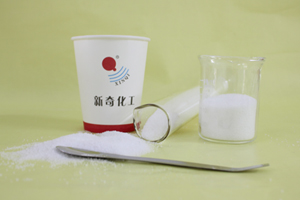Polyacrylamide (PAM)
Polyacrylamide is a synthetic polymer with a wide range of applications in various industries.
1. Chemical Structure and Properties
- Chemical Formula: The general formula of polyacrylamide is . It is a linear polymer that is formed by the polymerization of acrylamide monomers ().
- Solubility: It is water – soluble, which is a crucial property for many of its applications. The solubility depends on the degree of polymerization and the type of functional groups attached. PAM can form viscous aqueous solutions, and the viscosity can be adjusted according to the specific requirements of different processes.
- Molecular Weight: Polyacrylamide can have a wide range of molecular weights. Low – molecular – weight PAM is often used for applications such as flocculation aids, while high – molecular – weight varieties are suitable for applications like enhanced oil recovery and viscosity – enhancing agents.
2. Production Methods
- Polymerization: The most common production method is free – radical polymerization. Acrylamide monomers are polymerized in the presence of an initiator, such as a peroxide or a redox – initiator system. The reaction conditions, including temperature, pressure, and the presence of other additives, can influence the molecular weight and properties of the resulting polyacrylamide.
- Hydrolysis: Some polyacrylamide products are further hydrolyzed to introduce carboxyl groups (). This hydrolysis step can improve the performance of PAM in applications such as flocculation, as it can increase the anionic nature of the polymer and enhance its interaction with charged particles in the medium.
3. Applications
- Water Treatment
- Flocculation: PAM is widely used as a flocculant in water and wastewater treatment. In municipal wastewater treatment plants, it helps to aggregate and precipitate suspended solids such as dirt, clay, and organic matter. The flocculation process can significantly improve the efficiency of sedimentation and filtration steps, resulting in cleaner water output.
- Sludge Dewatering: In the treatment of sewage sludge, polyacrylamide can be used to enhance the dewatering process. By binding the water molecules in the sludge and improving the solid – liquid separation, it reduces the volume of sludge and makes it easier to handle and dispose of.
- Oil and Gas Industry
- Enhanced Oil Recovery (EOR): High – molecular – weight polyacrylamide is used in enhanced oil recovery methods. It can be injected into the oil reservoir to increase the viscosity of the water phase, which helps to drive the oil towards the production wells. This technique can significantly increase the amount of oil recovered from a reservoir.
- Drilling Fluids: PAM is also used in drilling fluids to control the rheological properties of the fluid. It can help to maintain the stability of the wellbore, prevent fluid loss into the formation, and carry the drilled cuttings to the surface.
- Paper and Pulp Industry
- Retention and Drainage: In papermaking, polyacrylamide is used as a retention and drainage aid. It helps to retain the fibers and fillers on the paper web during the formation process and improves the drainage of water from the pulp slurry. This results in better paper quality and higher production speeds.
- Mining Industry
- Mineral Processing: PAM is used in mineral processing to separate valuable minerals from gangue. It can help in the flotation process by improving the selectivity and aggregation of the target minerals.
4. Environmental and Safety Considerations
- Although polyacrylamide itself is generally considered to be of low toxicity, its monomers, acrylamide, are a neurotoxin and a potential carcinogen. Therefore, during the production and use of PAM, strict control of acrylamide content and handling procedures is necessary to ensure environmental and human safety. In water treatment applications, the residual polyacrylamide in the treated water is usually at a very low level and is generally considered to have a minimal impact on the environment and human health.

